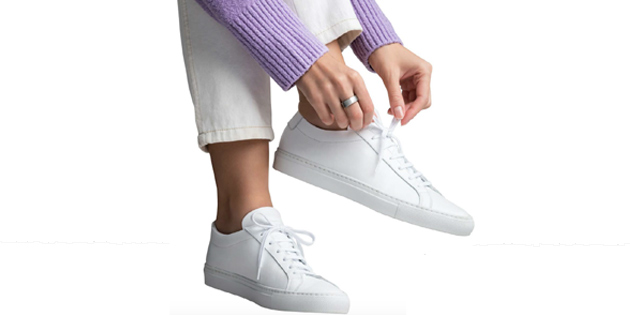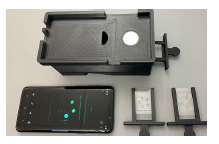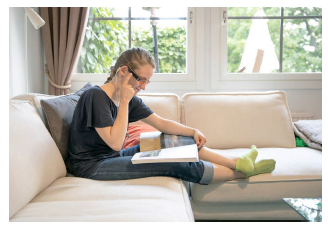Heat Monitoring Systems Could Help COVID-19 Diagnosis
Trend Watch: Wearables Contribute to Identifying COVID-19
 A smart ring, being developed by Oura, that generates continuous temperature data may foreshadow COVID-19, even in cases when infection is not suspected.
A smart ring, being developed by Oura, that generates continuous temperature data may foreshadow COVID-19, even in cases when infection is not suspected.
The device, which may be a better illness indicator than a thermometer, could lead to earlier isolation and testing, curbing the spread of infectious diseases, according to a preliminary study led by UC San Francisco and UC San Diego.
An analysis of data from 50 people previously infected with COVID-19, published online in the peer-reviewed journal Scientific Reports on Dec. 14, 2020, found that data obtained from the commercially available smart ring accurately identified higher temperatures in people with symptoms of COVID-19.
While it is not known how effectively the smart ring can detect asymptomatic COVID-19, which affects between 10% to 70% of those infected according to the Centers for Disease Control and Prevention, the authors reported that for 38 of the 50 participants, fever was identified when symptoms were unreported or even unnoticed.
Of note, the researchers analyzed weeks of temperature data to determine typical ranges for each of the 50 participants. “Many factors impact body temperature," says principal investigator and senior author Ashley Mason, Ph.D., assistant professor in the UCSF Department of Psychiatry and faculty at the UCSF Osher Center for Integrative Medicine. “Single-point temperature measurement is not very meaningful.People go in and out of fever, and a temperature that is clearly elevated for one person may not be a major aberration for another person.
Continual temperature information can better identify fever."
According to co-author Frederick Hecht, M.D., professor of medicine and director of research at the UCSF Osher Center for Integrative Medicine, this work is important for showing the potential of wearable devices in early detection of COVID-19, as well as other infectious diseases.
While the number of study participants was too small to extrapolate for the whole population, the authors said they were encouraged that the smart ring detected illness when symptoms were subtle or unnoticed. “This raises the question of how many asymptomatic cases are truly asymptomatic and how many might just be unnoticed or unreported," says author Benjamin Smarr, Ph.D., an assistant professor in the Department of Bioengineering and the Halicioğlu Data Science Institute at UC San Diego. “By using wearable technology, we’re able to query the body directly."
The researchers provided the rings to nearly 3,400 healthcare workers across the United States, and worked with Oura to invite existing users to participate in the study via the Oura app, resulting in enrollment of more than 65,000 participants worldwide in a now concluded prospective, observational study that the UC researchers are preparing for publication.
The participants in the preliminary study reported that they had previously been infected with COVID-19. A continuous record of their biomonitoring data was still available for analysis from the weeks before their infection, through the time of enrollment until the end of the study.
Other illness-associated changes that the rings detect included increased heart rate, reduced heart rate variability and increased respiration rate, but these changes were not as strongly correlated, the authors noted. The researchers are using the larger prospective study to develop an algorithm from data collected by wearable devices that can identify when it appears that the user is becoming sick. Dr. Mason’s team can then trigger a request for the user to complete with a self-collection COVID-19 test kit. The researchers will evaluate the algorithm in a new study of 4,000 more participants.
“The hope is that people infected with COVID will be able to prepare and isolate sooner, call their doctor sooner, notify any folks they’ve been in contact with sooner, and not spread the virus," Dr. Mason says.
Saliva COVID Test Uses Smartphone for Results in 15 Minutes
 Scientists at Tulane University have reported a new COVID-19 saliva test that uses a smartphone to provide results in as little as 15 minutes. Similar to technology from UC Berkeley that we reported on last month, the new test uses CRISPR technology and does not involve polymerase chain reaction (PCR) that, though accurate, is slow to deliver results.
Scientists at Tulane University have reported a new COVID-19 saliva test that uses a smartphone to provide results in as little as 15 minutes. Similar to technology from UC Berkeley that we reported on last month, the new test uses CRISPR technology and does not involve polymerase chain reaction (PCR) that, though accurate, is slow to deliver results.
The test is purportedly faster, more accurate, and easier to perform than existing gold standard PCR tests, while requiring less equipment and achieving results in minutes rather than days.
The new test detects RNA from the SARS-CoV-2 virus by relying on CRISPR to amplify the signal. The test involves mixing the assay solution with a sample of patient saliva on a special chip, which then heats and amplifies a specific region of the virus’s RNA.
According to a Tulane news announcement, a modified CRISPR complex that contains a guide RNA specific for this virus RNA region rapidly binds and cuts both this amplified RNA region and a tagged DNA probe to produce a fluorescent signal that is read by the smartphone device.
“This test addresses the critical needs for a rapid, ultrasensitive COVID-19 diagnosis along with effective large-scale screening efforts," says Tony Hu, Ph.D., corresponding author of the study. “Our development can quickly identify patients who have the virus, which is required to help address the ongoing threat to public health worldwide. The sensitivity and simplicity of this test, its straightforward sample collection procedure, and the inexpensive nature of the readout device should permit the rapid translation of this approach to COVID-19 testing efforts once we obtain FDA approval."
Smart Patch Created for Workplace Safety Repurposed for COVID
 Kenzen, the smart PPE innovator focused on physiological monitoring and the prevention of heat injury and death among workers, has created a real-time worker heat monitoring system that could be used for early detection of fever, which might help reduce the spread of COVID-19 and other illnesses in the workplace. The Kenzen system has been piloted on worksites of large industrial conglomerates across the globe in domains such as construction, field services, power, oil and gas, and renewable energy. In the future, open APIs will allow integration into large connected-worker platforms.
Kenzen, the smart PPE innovator focused on physiological monitoring and the prevention of heat injury and death among workers, has created a real-time worker heat monitoring system that could be used for early detection of fever, which might help reduce the spread of COVID-19 and other illnesses in the workplace. The Kenzen system has been piloted on worksites of large industrial conglomerates across the globe in domains such as construction, field services, power, oil and gas, and renewable energy. In the future, open APIs will allow integration into large connected-worker platforms.
Occupational Health & Safety Magazine recognized the Kenzen smart patch with a 2020 New Product of the Year award. The cloud-based software-as-a-service system includes a wearable device worn by workers on their arm, which alerts both the worker and their supervisor when core body temperature is too high.
The wearable, via its advanced sensor compliment, monitors multiple physiological and environmental metrics, including heart rate, activity, skin, and ambient temperatures. Together, this sensor data allows for the real-time prediction of core body temperature, providing alerts to workers and supervisors when temperatures approach unsafe levels.
Individual workers can use the mobile app to track their personal metrics; the app also sends alerts telling them to stop work if they’re overheated or need to rehydrate. The Web-based team dashboard allows leaders to track their team’s wellness based on de-personalized, anonymous data.
Two Separate Companies Develop Devices to Assist the Visually Challenged
 OrCam Technologies has developed a wearable device that can instantly read text from any surface, recognize faces, and identify products. What hearing aids are to hearing, OrCam hopes its MyEye device will be for vision. The company bills the product as a revolutionary voice-activated device that attaches to virtually any glasses that can instantly read to you text from a book, smartphone screen, or any other surface, recognize faces, help you shop on your own, work more efficiently, and live a more independent life. OrCam notes the MyEye processes everything locally on the device, which it claims protects the user’s privacy.
OrCam Technologies has developed a wearable device that can instantly read text from any surface, recognize faces, and identify products. What hearing aids are to hearing, OrCam hopes its MyEye device will be for vision. The company bills the product as a revolutionary voice-activated device that attaches to virtually any glasses that can instantly read to you text from a book, smartphone screen, or any other surface, recognize faces, help you shop on your own, work more efficiently, and live a more independent life. OrCam notes the MyEye processes everything locally on the device, which it claims protects the user’s privacy.
“The purpose of the OrCam MyEye platform is to enable people who are blind or visually impaired access to their visual world, and by doing so open up new opportunities for employment, studies, and leisure activities," says Professor Amnon Shashua, co-founder and co-CEO of OrCam Technologies.
Another company, Envision, an award-winning AI-assistive technology company, has launched Envision Glasses, AI-powered assistive glasses.
Envision’s software uses AI to extract information from images and then speaks the images out loud so the user has a greater understanding of the environment around him or her. Blind and low-vision users can “see" to read documents at home or work, view labels while shopping, easily recognize their friends, find personal belongings at home, use public transport, video call anyone in real time, and more.
The launch of Envision Glasses builds off of the success of the company’s popular, AI-assistive iOS and Android smartphone app, which was named Best Accessibility App at the 2019 Google Play Awards and a Hall of Fame Award Winner by AppleVis, which showcases the best accessible iOS apps.
Sleep Apnea Testing at Home
 A Belgian tech startup company Sunrise has developed an at-home sleep apnea test that relies on a small wearable device. The device consists of a small sensor that users can attach to their chin when they are about to go to sleep. The sensor records movements of the jaw, which it correlates with sleep events using artificial intelligence.
A Belgian tech startup company Sunrise has developed an at-home sleep apnea test that relies on a small wearable device. The device consists of a small sensor that users can attach to their chin when they are about to go to sleep. The sensor records movements of the jaw, which it correlates with sleep events using artificial intelligence.
The small sensor, weighing three grams, was launched in the U.K. On measuring the movements in the chin, the company lets everyone take up a clinical test from the comfort of their home in a natural sleeping environment, thereby eliminating the need for individuals to sleep in a hospital bed amid endless wires and equipment. Founded by Laurent Martinot and Pierre Martinot in 2015, Sunrise already launched its services in France and Belgium. So far, the company has served nearly 10,000 consumers successfully and has helped them realize their desire for a good night’s sleep. The company continues to expand its list of partnered physicians as it intends to become a national facilitator between physicians and patients.
Verily Continues Expansion into Life-Sciences Programs
At the end of last year, Verily, the life-sciences arm of Alphabet, raised $700 million in capital to expand its commercial business, including its clinical healthcare platform Baseline, which it has used for COVID-19 research.
The investment came not only from Alphabet, but from other investors outside the Google parent company which were already invested in Verily, including Temasek, OntarioTeachers’ Pension Plan, and Silver Lake. Company officials said the funds will be used to “progress" several of its life-sciences programs, including surgery, pathology, and immunology.
Verily says Project Baseline’s mission is collaborating to build the next generation of healthcare tools and services, which is an initiative that maps health data points used in clinical research. (PV)


















